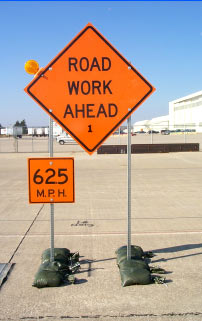Construction site safety
File:A construction framer talks about protecting his crew from falls.webm
Construction site safety is a branch of occupational safety and health focused on the protection of construction workers who are susceptible to various hazards that can lead to injuries, illnesses, or fatalities. Construction sites are dynamic environments with unique challenges, thus requiring comprehensive safety measures, regulations, and practices to mitigate risks.
Overview[edit | edit source]
Construction work is inherently dangerous, involving tasks such as heavy lifting, working at heights, operating heavy machinery, and exposure to potentially harmful substances. The primary goal of construction site safety is to create a safe working environment by identifying potential hazards, implementing preventive measures, and ensuring that all workers are adequately trained.
Regulations and Standards[edit | edit source]
In many countries, construction site safety is governed by specific laws and regulations. These are often enforced by a governmental agency, such as the Occupational Safety and Health Administration (OSHA) in the United States, which sets and enforces standards to ensure workplace safety and health. Compliance with these regulations is mandatory, and failure to adhere can result in fines, legal action, or cessation of construction activities.
Hazards on Construction Sites[edit | edit source]
Construction sites can present a wide range of hazards, including but not limited to:
- Falls from heights, which are among the leading causes of fatalities in construction.
- Electrical hazards, including electrocution from contact with live wires.
- Trench collapse and excavation hazards.
- Exposure to hazardous substances, such as asbestos, lead, and silica dust.
- Noise-induced hearing loss due to high decibel levels.
- Machinery accidents, involving the operation of heavy equipment.
Safety Measures[edit | edit source]
To combat these hazards, several safety measures are implemented on construction sites:
- Personal Protective Equipment (PPE), such as helmets, safety glasses, high-visibility clothing, and steel-toed boots, to protect workers from injury.
- Safety training programs to educate workers on hazard recognition and safe work practices.
- Implementation of fall protection systems, including guardrails, safety nets, and personal fall arrest systems.
- Regular safety inspections and audits to identify and rectify potential hazards.
- Emergency preparedness plans to respond effectively to accidents and incidents.
Roles and Responsibilities[edit | edit source]
Ensuring safety on a construction site is a collective responsibility. Key roles include:
- Employers, who are responsible for providing a safe work environment, adequate training, and necessary protective equipment.
- Safety officers, tasked with implementing and monitoring safety policies and procedures.
- Workers, who must follow safety rules, use PPE properly, and report unsafe conditions or practices.
Challenges[edit | edit source]
Despite stringent regulations and safety measures, construction sites face challenges such as:
- The temporary and ever-changing nature of construction sites, which can make consistent safety practices difficult to maintain.
- The high turnover rate of workers, which can result in a workforce that is not always adequately trained.
- Language barriers and cultural differences among workers, which can complicate communication and safety training.
Conclusion[edit | edit source]
Construction site safety is critical for preventing accidents and ensuring the well-being of workers. Through adherence to regulations, continuous training, and a culture of safety, the construction industry can mitigate risks and create safer work environments.
This safety related article is a stub. You can help WikiMD by expanding it.
Search WikiMD
Ad.Tired of being Overweight? Try W8MD's physician weight loss program.
Semaglutide (Ozempic / Wegovy and Tirzepatide (Mounjaro / Zepbound) available.
Advertise on WikiMD
|
WikiMD's Wellness Encyclopedia |
| Let Food Be Thy Medicine Medicine Thy Food - Hippocrates |
Translate this page: - East Asian
中文,
日本,
한국어,
South Asian
हिन्दी,
தமிழ்,
తెలుగు,
Urdu,
ಕನ್ನಡ,
Southeast Asian
Indonesian,
Vietnamese,
Thai,
မြန်မာဘာသာ,
বাংলা
European
español,
Deutsch,
français,
Greek,
português do Brasil,
polski,
română,
русский,
Nederlands,
norsk,
svenska,
suomi,
Italian
Middle Eastern & African
عربى,
Turkish,
Persian,
Hebrew,
Afrikaans,
isiZulu,
Kiswahili,
Other
Bulgarian,
Hungarian,
Czech,
Swedish,
മലയാളം,
मराठी,
ਪੰਜਾਬੀ,
ગુજરાતી,
Portuguese,
Ukrainian
Medical Disclaimer: WikiMD is not a substitute for professional medical advice. The information on WikiMD is provided as an information resource only, may be incorrect, outdated or misleading, and is not to be used or relied on for any diagnostic or treatment purposes. Please consult your health care provider before making any healthcare decisions or for guidance about a specific medical condition. WikiMD expressly disclaims responsibility, and shall have no liability, for any damages, loss, injury, or liability whatsoever suffered as a result of your reliance on the information contained in this site. By visiting this site you agree to the foregoing terms and conditions, which may from time to time be changed or supplemented by WikiMD. If you do not agree to the foregoing terms and conditions, you should not enter or use this site. See full disclaimer.
Credits:Most images are courtesy of Wikimedia commons, and templates Wikipedia, licensed under CC BY SA or similar.
Contributors: Prab R. Tumpati, MD



